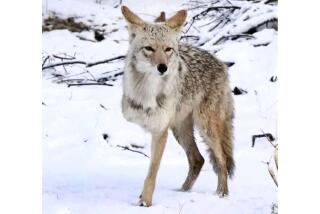Anza-Borrego Desert is fertile ground for filming
When the producers of “Last Days in the Desert” needed an environment for their biblical allegory, they knew just where to travel. They headed 31/2 hours southeast of Los Angeles to one of the largest state parks in the country.
Spanning 600,000 acres, hundreds of miles of dirt roads and a dozen wilderness areas, Anza-Borrego Desert State Park has been an attractive, if underused, film location, featured in such movies as Warren Beatty’s “Bugsy” and the Universal Pictures action film “The Scorpion King.”
But the producers behind “Last Days in the Desert” liked the park so much that they opted to shoot all 24 days in the vast wilderness, which is named after 18th century Spanish explorer Juan Bautista de Anza.
ON LOCATION: Where the cameras roll
The low-budget independent film, which wrapped filming Friday, marks the first time the state park has hosted an entire feature production, according to the California Film Commission.
“I can’t think of another movie that filmed entirely in the desert,” said Amy Lemisch, executive director of the California Film Commission, which helped the crew secure permits for filming in the park. “It’s pretty unique.”
What was the appeal?
“It’s an incredibly beautiful location, it hasn’t been shot very much, and it’s close to home, where we can have the best artists in the world on the movie,” said Bonnie Curtis, who produced the film with partner Julie Lynn and Division Films.
“There were several days of shooting,” Lynn said, “where we looked at each other and said, ‘No one is going to believe us. They’re going to think we put a painting behind the actors.’”
Their company, Mockingbird Pictures, also produced the 2011 movie “Albert Nobbs” and the recently released “The Face of Love,” with Annette Bening, Ed Harris and Robin Williams.
PHOTOS: Box office top 10 of 2013 | Biggest flops of 2013
As with “The Face of Love,” which filmed heavily in Venice and throughout Los Angeles County, “Last Days in the Desert” received a state film tax credit. The producers, who were among more than 300 filmmakers who applied for a piece of the $100 million the state allocates annually, initially didn’t win the lottery. They were put on a waiting list.
When other applicants dropped out, Mockingbird learned in December that it had qualified for a $700,000 tax credit (to offset less than $3 million in spending that qualifies for the state program), state records show. The tax credit was a key element in financing the movie, Curtis said.
“If we didn’t have a tax credit on this movie, I’m almost certain we would have walked away from the movie,” Curtis said.
California’s arid landscapes have long whetted the appetites of location scouts. Deserts in San Bernardino County have stood in for Afghanistan (“Iron Man”), Planet Vulcan (“Star Trek”), Morocco (“Hidalgo”) and even Iwo Jima (“Letters From Iwo Jima”). And the arid landscapes in the Antelope Valley and Mojave Desert also have been highlighted in such movies as “Planet of the Apes,” “Land of the Lost” and “Hulk.”
Because of its remote location, Anza-Borrego gets fewer film shoots than other deserts in Southern California. The park issued 31 film permits in the last two years, mainly for commercials, still photo shoots, reality shows and a few indie films, Lemisch said.
From writer-director Rodrigo Garcia, “Last Days in the Desert” takes place three decades after Jesus’ birth and centers on a holy man and a demon — both roles played by Ewan McGregor — on a journey through the desert. Mexican cinematographer Emmanuel Lubezki, who won an Academy Award for best cinematography for his work on “Gravity,” was the film’s director of photography.
FACES TO WATCH 2014: Digital media
The crew set up base camp at Borrego Springs Resort and filmed everything on location in various corners of the sprawling park, including Font’s Point, which overlooks the Borrego Badlands and was the site of the HBO miniseries “From the Earth to the Moon,” according to the book “Hollywood Escapes.”
The filmmakers worked with park rangers to help identify sites where they could film without harming the park’s flora and fauna. The only sets were a Bedouin tent and a structure built of stones.
A crew of 30 to 40 people filmed on a dry lake bed and in slot canyons. They used four-wheel-drive vehicles to navigate the dirt roads and had to walk a quarter of a mile to a film site that was off-limits to vehicles.
Aside from a windstorm, the biggest hurdle was the heat, which climbed into the 90s at one point, requiring the crew to load up on bottled water. Then there was the sand.
“The first few days, you try to clean it off — off your face, your clothes, your equipment, whatever that might be, from a camera, to an iPad, to a makeup kit.... Then you just kind of give up,” Curtis said. “You sit in it, eat in it. Sand is your life. You become part of it.”







